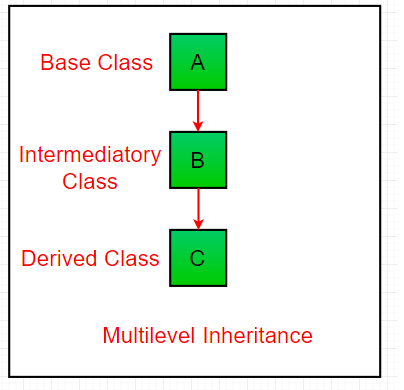Introduction to Inheritance:
Inheritance is a fundamental concept in object-oriented programming (OOP) that allows you to create new classes based on existing classes, inheriting their attributes and behaviors. Python, a versatile and popular programming language, supports several types of inheritance to facilitate code reuse and maintainability. In this blog post, we will explore the different types of inheritance in Python and how they can be used effectively.
Understanding Inheritance:
Inheritance enables you to create a new class (known as a derived or child class) that inherits properties and methods from an existing class (known as a base or parent class). This relationship is often referred to as an “is-a” relationship, indicating that the derived class is a specialized version of the base class.
To establish inheritance in Python, you use the following syntax:

Types Of Inheritance:

1. Single Inheritance:
Single inheritance is the simplest form of inheritance, where a derived class inherits from a single base class. In this scenario, the derived class inherits all the attributes and methods of the base class.

To establish Single-inheritance in Python, you use the following syntax:

In this example, the Dog class inherits the speak() method from the Animal class and provides its implementation.
2. Multiple Inheritance:
Multiple inheritance allows a derived class to inherit from more than one base class. This feature allows you to combine the attributes and methods of multiple classes into a single derived class.

To establish Multiple-inheritance in Python, you use the following syntax:

In this case, the C class inherits from both A and B, allowing instances of C to access the methods from both base classes.
3. Multilevel Inheritance
Multilevel inheritance involves a chain of inheritance, where a derived class becomes the base class for another class. This creates a hierarchical structure of classes

To establish Multilevel-inheritance in Python, you use the following syntax:

In this example, the Child class inherits from Parent, which in turn inherits from Grandparent. Thus, Child has access to the methods of both Parent and Grandparent.
4. Hierarchical Inheritance:
Hierarchical inheritance occurs when multiple derived classes inherit from a single base class. Each derived class shares the attributes and methods of the base class but may have its unique functionality.

To establish Hierarchical-inheritance in Python, you use the following syntax:

In this scenario, both the Car and Bicycle classes inherit the start_engine() method from the Vehicle class, but they also have their specific methods.
5. Hybrid Inheritance
Hybrid inheritance is a combination of multiple inheritance types within a single program. It can involve various combinations of single, multiple, multilevel, and hierarchical inheritance.

To establish Hybrid-inheritance in Python, you use the following syntax:

In this example, class D uses multiple inheritance, inheriting from both B and C, which themselves inherit from A.
Conclusion:
Inheritance is a powerful mechanism in Python that allows you to create hierarchies of classes, promoting code reusability and organization. Understanding the various types of inheritance — single, multiple, multilevel, hierarchical, and hybrid — can help you design more efficient and maintainable object-oriented Python programs. Choose the type of inheritance that best suits your project’s requirements to write cleaner, more structured code.
